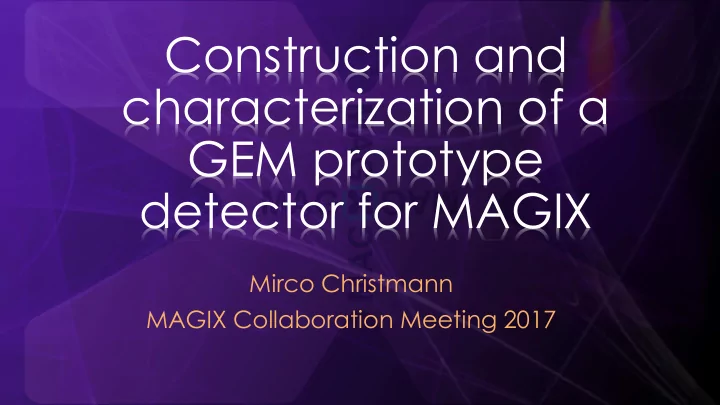

Construction and characterization of a GEM prototype detector for MAGIX Mirco Christmann MAGIX Collaboration Meeting 2017
Outline • detector challenges • construction of a GEM prototype detector • data acquisition • laboratory measurements • measurements in the electron beam of MAMI • summary and outlook 2
Detector challenges • precise detector system active area: 1.20 x 0.30 m 2 spatial resolution < 50 μm multiple points for track reconstruction high rate capability O(1 MHz) • alternative to drift chambers 3
GEM detectors • they satisfy this criteria • GEM foils have a low radiation length as well • high electric fields in the holes e - avalanche 4
Construction of a GEM detector • stretching and framing the foils • condition at delivery • active area: 10 x 10 cm 2 • electrical contacts • leakage current < 10 nA @ 500 V 5
Construction of a GEM detector • stretching and framing the foils • coefficient of thermal expansion is different • cooled frame for stretching • laboratory oven stretching 6
Construction of a GEM detector • stretching and framing the foils • glue a fibreglass frame on the foil • cures in the laboratory oven • cut into shape • check leakage current again 7
Construction of a GEM detector • stretching and framing the foils • glue a fibreglass frame on the foil • cures in the laboratory oven • cut into shape • check leakage current again 8
Construction of a GEM detector • profile measurements of the foils • evaluate the stretching procedure • laser sensor • plane table • curvature much lower than for pre- framed ones 9
Construction of a GEM detector • additional detector components needed • 512-channel readout board 10
Construction of a GEM detector • additional detector components needed • 512-channel readout board • chamber (frame and cap) • high voltage connection box 11
Construction of a GEM detector • additional detector components needed • 512-channel readout board • chamber (frame and cap) • high voltage connection box • gas system 12
How to readout data? • SRS ( Scalable Readout System ): data acquisition • APV cards (128 channels each) 13
How to readout data? • SRS ( Scalable Readout System ): data acquisition • APV cards (128 channels each) • scintillators for trigger signal 14
How to readout data? • SRS ( Scalable Readout System ): data acquisition • APV cards (128 channels each) ① synchronisation peaks • scintillators for ② separation of timing frames trigger signal ③ signal in a timing frame • APV signals 15
How to readout data? • SRS ( Scalable Readout System ): data acquisition • APV cards (128 channels each) • scintillators for trigger signal • APV signals • 1-d hit position • hit time 16
Lab measurements • basic tests with more simple setups photo peak 5,89 keV • energy resolution escape peak 2,9 keV 55 Fe-Spectra • FWHM: 16% 17
Lab measurements • basic tests with more simple setups • energy resolution 55 Fe-Spectra • • gain curve (vary U GEM ) 18
Lab measurements • basic tests with more simple setups • energy resolution 55 Fe-Spectra • • gain curve (vary U GEM ) • homogeneity test • cosmics • less events at the edges geometry of the setup 19
Lab measurements • basic tests with more simple setups • energy resolution 55 Fe-Spectra • • gain curve (vary U GEM ) • homogeneity test • cosmics • less events at the edges geometry of the setup 20
MAMI beam time @X1 • 28/29th of June 2016 • behind HV-MAPS • detector on xy-table, scintillators fixed • up to 350 fA • 855 MeV 21
Filtering the raw data • filter out the noise • pulse width at 20% of Q max 22
Filtering the raw data • filter out the noise • pulse width at 20% of Q max • distribution of pulse widths [25 ns] 23
Filtering the raw data (A) width 1x25 ns (C) width 10x25 ns (B) width 4x25 ns (D) width 14x25 ns 24
Filtering the raw data • filter out the noise • pulse width at 20% of Q max • distribution of pulse widths [25 ns] • B+D: mainly double hits • A: mainly noise • second filter: charge 25
Results: High Rate Tests • 6 series of measurement: 0.5 - 2.2 MHz • limited by trigger system • electron detection at 1 MHz with efficiency >99.9% • at maximum rate: efficiency >99.5% requirement full-filled 26
Results: XY-Scan • 25 series of measurement: 11.4 kHz, raster pitch 2 cm • 9 measurements in the middle: 99.85±0.04% efficiency • lower efficiencies @ edges 27
Results: XY-Scan • 25 series of measurement: 11.4 kHz, raster pitch 2 cm • 9 measurements in the middle: 99.85±0.04% efficiency • lower efficiencies @ edges • alignment of detector shift in beamspot positions 28
Summary & Outlook • stretching and framing procedure • profile measurements uniform result • readout data: 512 crossed copper stripes SRS • filter data by pulse width • high rate tests efficiency >99.9% @ 1 MHz • XY-Scan 99.85±0.04% efficiency in the middle 29
Summary & Outlook • go bigger • 30 x 30 cm 2 GEMs are ordered • same procedure (stretching, framing, …) • go thinner • thinner GEMs are ordered (10x10 cm²) • foil based readout (Master Thesis: Yasemin Schelhaas) 30
THANK YOU FOR YOUR ATTENTION! http://magix.kph.uni- mainz.de
Recommend
More recommend